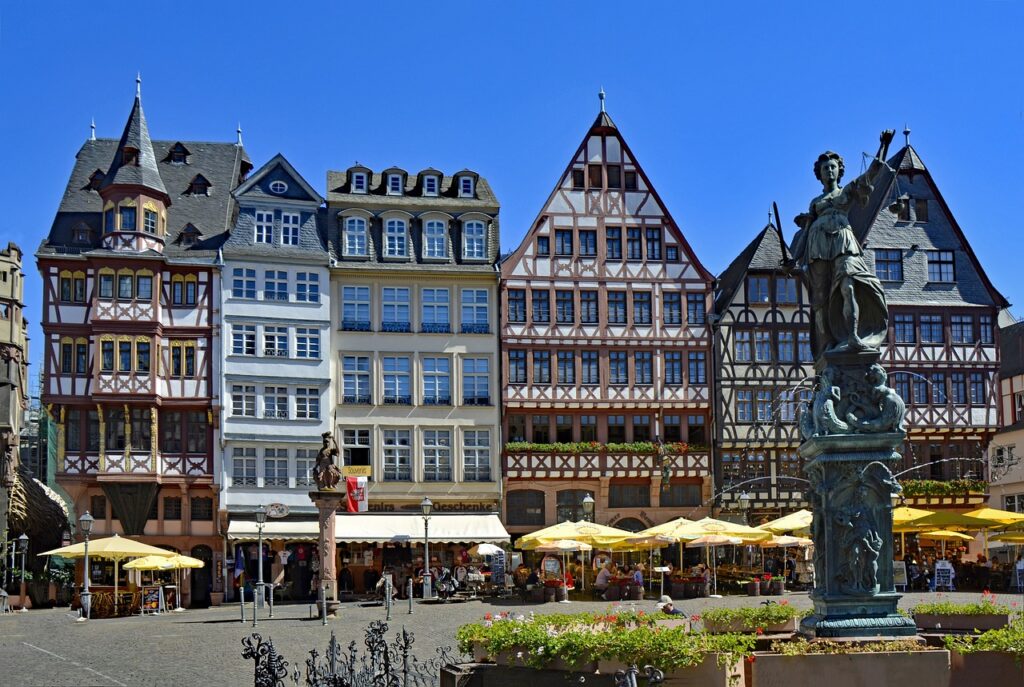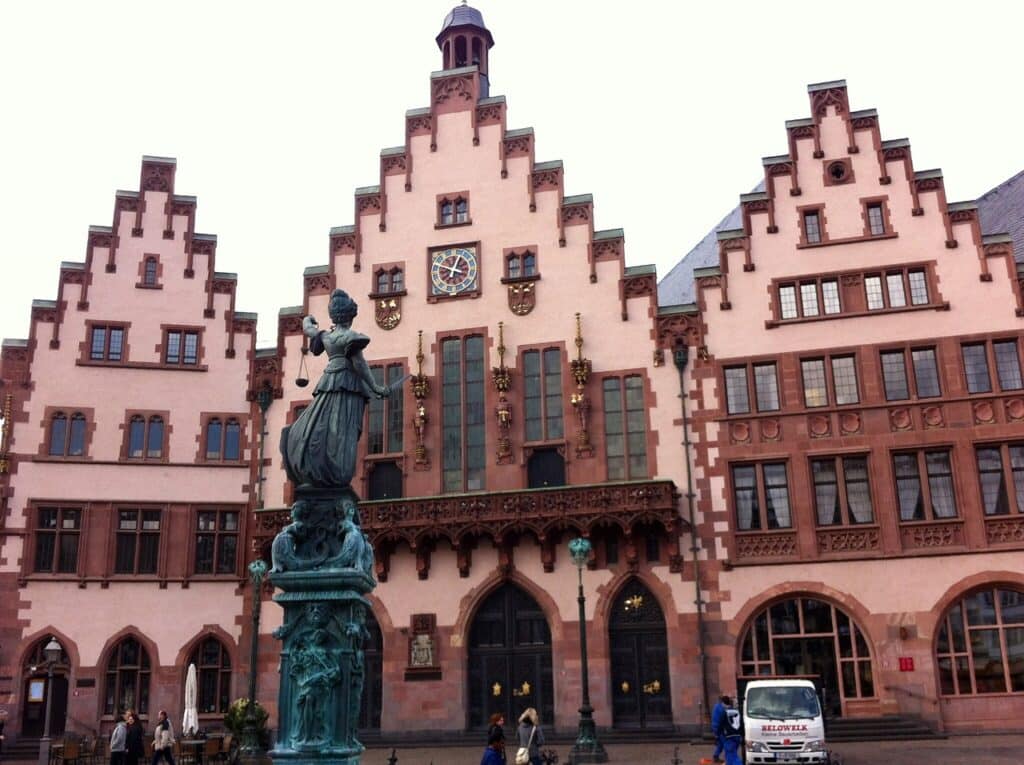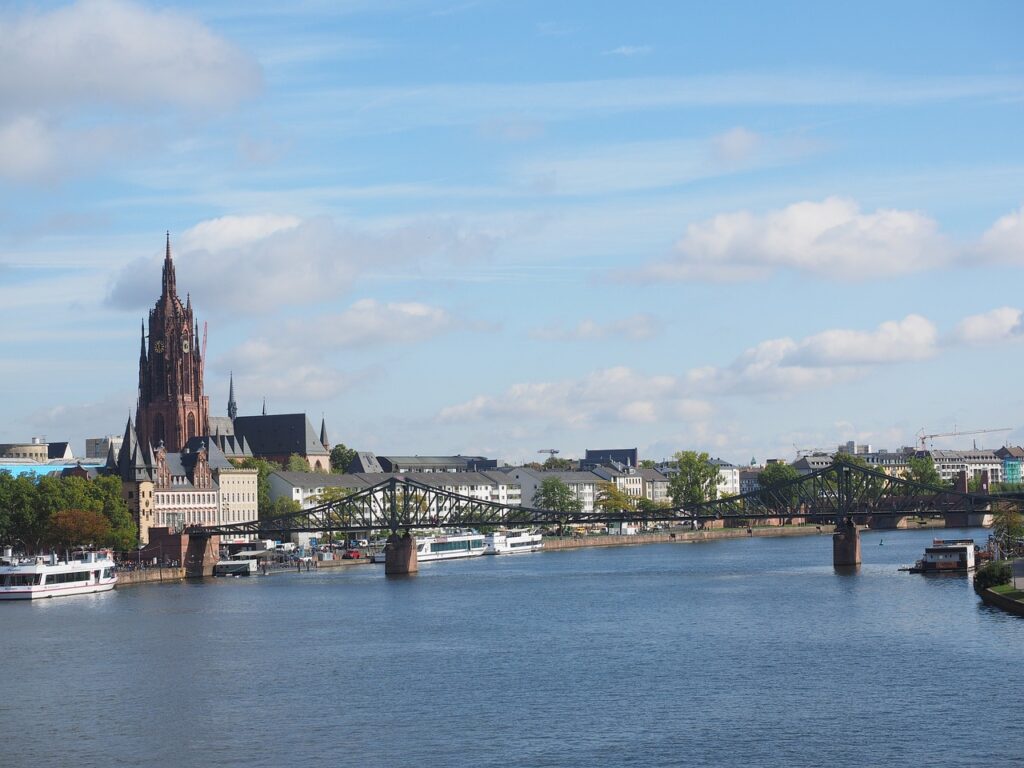Frankfurt: The Confluence of History, Modernity, and Globalization
Frankfurt, officially known as Frankfurt am Main, is the most populous city in the German state of Hesse. With a population of approximately 791,000 inhabitants, it stands out as the fifth most populous city in Germany. This complete guide to Frankfurt am Main in Germany will help you explore what truly distinguishes it – its status as a “world alpha city,” as classified by the GaWC, putting it at the center of global attention.

Located on the banks of the Main River, from which it derives its name, Frankfurt is the heart of the Rhine-Main metropolitan region, which has a total population of over 5.8 million, making it the second largest metropolitan region in Germany, after the Rhine-Ruhr region.
It stands out as one of the major financial centers in Europe, housing the headquarters of the European Central Bank, the Frankfurt Stock Exchange, and several renowned banking institutions such as Deutsche Bank and Commerzbank. Additionally, Frankfurt is a global hub for trade, culture, education, tourism, and transportation.
Frankfurt’s central location in former West Germany has made Frankfurt Airport the busiest in Germany and one of the busiest in the world. The airport not only serves as a crucial transit point for international travelers but also as the main hub for Lufthansa, Germany’s national airline.
Foundation of Frankfurt
The history of Frankfurt dates back to the Roman Empire, with settlements established in the area along the Nidda River during the reign of Emperor Vespasian, between 69 and 79 AD. Throughout the centuries, the city has played crucial roles in historical events, from being one of the two capitals of Louis the German, grandson of Charlemagne, to being the site of imperial coronations during the Holy Roman Empire.
Exploring the Architecture and Culture of Frankfurt

1. The iconic skyscrapers and the modern urban landscape:
- Frankfurt is shaped by some of the tallest skyscrapers in Europe, which has led to the term “Mainhattan,” a combination of the local river, the Main, and “Manhattan.” This distinctive urban landscape is one of the reasons why Frankfurt is often referred to as the “Manhattan of Europe.”
- The city boasts many high-rise buildings that form its renowned skyline. In fact, it is one of the few cities in the European Union to have such a skyline.
2. Historic neighborhoods and their unique characteristics:

- Before World War II, the city was known for its old town, the largest timber-framed old town in Europe. The Römer area was rebuilt and is popular among visitors and for events, such as the Frankfurt Christmas Market.
- Other parts of the old town were reconstructed as part of the Dom-Römer Project from 2012 to 2018.
3. Museums, theaters, and cultural spaces not to be missed:
- Frankfurt is home to influential educational institutions, including Goethe University and the largest German-language library, the German National Library.
- The city boasts many renowned museums, 26 of which are lined along the Museum Embankment, including the Liebieghaus, the German Film Museum, the Senckenberg Natural History Museum, the Goethe House, and the Schirn art venue.
4. Local culinary tips and traditional dishes:
- Frankfurt’s cuisine is diverse and reflects its position as a cosmopolitan center. A traditional dish is the “Frankfurter Würstchen,” a smoked sausage that has become famous worldwide.
- Other traditional dishes include “Grüne Soße,” a herb-based sauce, and “Handkäse mit Musik,” a cheese served with onions.
Main attractions of Frankfurt

The Old Town of Frankfurt (Frankfurter Altstadt): The Altstadt, or Old Town, is the medieval core of Frankfurt. Picture yourself strolling through streets that were once enclosed by the Staufenmauer, the city’s ancient wall. Before the devastation of World War II, this area was a maze of around 1,250 timber-framed buildings, many of which dated back to the Middle Ages.
Römerberg – The Heart of the Altstadt: Begin your journey at Römerberg square, the historic center of the Altstadt. Here, you’ll find the Römer, the city’s historic town hall that has served as such for over 600 years. This square has been the scene of coronations, festivals, and even executions. Today, it’s a bustling spot, teeming with tourists and locals alike, and it’s the perfect place to start exploring.
Reconstruction and Renewal: Following the bombings of 1944, the Altstadt had to be rebuilt. Between 2012 and 2018, the “Dom-Römer-Projekt” brought back the magic of the Old Town, restoring ancient streets and squares. As you walk, you can feel the blend of old and new, a testament to Frankfurt’s resilience.
Römer (Town Hall): One of Frankfurt’s most iconic buildings, it has served as the city’s town hall for over 600 years.

Kaiserdom St. Bartholomäus (Imperial Cathedral of Saint Bartholomew): A Gothic church that played a significant role in German history as the site of election and coronation of Holy Roman Emperors.
Paulskirche (Church of Saint Paul): Known as the cradle of German democracy, it was the venue for the first German National Assembly in 1848.


Frankfurter Goethe-Haus (Goethe House in Frankfurt): The residence where the renowned German writer Johann Wolfgang von Goethe was born and raised.
Eiserner Steg (Iron Bridge): A pedestrian bridge over the River Main that offers panoramic views of the city.

Main Tower with Observation Deck: One of Frankfurt’s tallest skyscrapers, offering a panoramic view of the city from its observation deck.
Zoo Frankfurt: One of Germany’s oldest zoos, home to a variety of animals from around the world.
Museumsufer Frankfurt (Museum Embankment Frankfurt): The Museumsufer, in Frankfurt, is a unique cultural area located along the banks of the River Main. The name “Museumsufer” translates to “Museum Embankment,” and this stretch of the river is famous for hosting an impressive concentration of renowned museums and cultural institutions. Some of Europe’s most important and interesting museums are located along the Museumsufer. Some of the notable museums include: Städel Museum, German Architecture Museum, Jewish Museum Frankfurt, which narrates the history of the Jewish community in Frankfurt and displays important artifacts related to Jewish life and culture, among other museums.
Städel Museum: The Städel Museum was established in 1815 and brings together over 700 years of art history. Its beautiful exhibitions span from the 1300s to the present day. The highlight lies in the exquisite paintings that tell the story of art history, featuring renowned names such as Botticelli, Rembrandt, Monet, and Vermeer, among many others. Johann Friedrich Städel (1728 – 1816) founded the museum, with artworks he had collected throughout his life, always with the intention of creating exhibitions. Some of the stunning artworks displayed in the museum:



Detailed History of Frankfurt
From Medieval Origins to Modernity: The Evolution of Frankfurt
The foundation of the city and its significance in the Middle Ages: The city also held a prominent position in the Holy Roman Empire. From 855 onwards, German kings and emperors were elected in Frankfurt and crowned in Aachen. Starting from 1562, kings and emperors were also crowned in Frankfurt, with Maximilian II being the first to be crowned in the city. This tradition continued until 1792 when Francis I was elected and crowned.
The foundation of the city and its significance in the Middle Ages: Frankfurt, from its inception, held a strategic geographic position with roots dating back to the Roman Empire. In the Römer area, Roman settlements were likely established in the 1st century, with artifacts from that time still found today. In the medieval period, major European trade routes intersected on the Main, making the city a crucial point for trade. The autumn and spring fairs transformed Frankfurt into a center of international trade. The city was known as the “Kaufhaus der Deutschen” (Warehouse of the Germans). Since 1480, the Frankfurt Book Fair has become an integral part of the city’s culture, consolidating Frankfurt as one of Europe’s largest book centers.
Frankfurt’s role during the Reformation and the Renaissance: The city played a fundamental role as a financial center since ancient times. In 1402, the city’s first exchange house was established. In 1585, a request from 82 merchants marked the beginning of the Frankfurt Stock Exchange. These merchants, hailing from cities like Nuremberg and Antwerp, laid the foundation for what would become one of the world’s most influential stock exchanges.
The city during the two World Wars and its reconstruction: After World War II, Frankfurt emerged as a dominant financial center. The “Bank deutscher Länder” was established in 1948, playing a crucial role in Germany’s monetary reform. This institution later evolved into the Deutsche Bundesbank in 1957.
Frankfurt in the 21st century: a global center: Currently, Frankfurt is home to about 260 national and international banking institutions. Since 1998, the city has also been home to the headquarters of the European Central Bank. With Brexit, many banks are considering Frankfurt as an alternative to London, further solidifying the city’s position as a global financial metropolis.
Urban Development and Infrastructure: Since the annexation by the Prussians in 1866, Frankfurt has steadily grown into a major city. The city has benefited from its modern transportation infrastructure, including the opening of the “Centralbahnhof Frankfurt” in 1888, which was the largest railway terminal in Europe at the time. In 1909, the city hosted the International Aeronautics Exhibition, and shortly after, the first airport was established. Today, Frankfurt Airport is one of the busiest in the world, serving as a gateway to Germany and Europe.
Culture and Society: Diversity and internationality are intrinsic characteristics of Frankfurt. Neighborhoods like Bahnhofsviertel are a testament to the city’s rich cultural tapestry. The city has a long tradition of welcoming people from different backgrounds, dating back to the arrival of Protestant refugees in the 16th and 17th centuries.
Exclusive Services from Viagem Alemanha in Frankfurt – Brazilian Guides
Viagem Alemanha is pleased to present its specialized services for those who wish to explore Frankfurt and all of Germany with the expertise of Brazilian guides.

Specialized Guides: Our oficial guides, fluent in English, Spanish and Portuguese, are knowledgeable about the rich historical and cultural tapestry of Frankfurt and are prepared to provide a unique and enriching experience.
Personalized Tours: We offer customized tours tailored to your preferences and interests in all of Germany. Whether it’s an immersion in the history of Frankfurt, an exploration of modern architecture, or a gastronomic journey, we are here to meet your expectations.
Safe and Efficient Transfers: We guarantee your arrival and departure from Frankfurt smoothly and safely with our transfer services, providing convenience from the moment of your arrival to your departure.
Day Trips from Frankfurt: Explore beyond Frankfurt with our day trips. Discover nearby cities and regions and delve even deeper into German culture and history.
Coverage Across Germany: Besides Frankfurt, Majestic Germany offers services across the entire German territory, ensuring that your experience is consistent and high quality, regardless of where your journey takes you.
We invite you to discover Frankfurt and Germany with us, ensuring an unforgettable trip, rich in discoveries and authentic experiences. Contact us for more information and to plan your next adventure.

